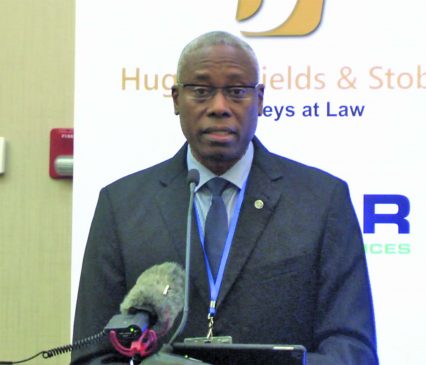
As Guyana moves towards an oil-producing nation, calls are being made for protection of the country’s marine life, now that exploration is at its peak and extraction slated to commence in 2020.
These calls are made on Wednesday when the Maritime Administration of Guyana (MARAD) hosted the Maritime Conference 2019.
The conference features international and local stakeholders exploring different measures which the country can undertake before 2020, the year when oil is expected to be harnessed.
According to the Regional Advisor from the International Maritime Organisation (IMO), Colin Young, efforts must be made to protect marine life through acquisition of the IMO standards, which also govern safety and security of exploration vessels.
He said the Government “is urged to consider that implementation is critical to safeguarding Guyana’s marine environment within which port-state inspection plays a crucial role in ensuring that shipping takes place securely, safely, and efficiently on clean oceans.”
The IMO is considered a global agency, which creates standards and regulates the performance of international shipping. Through a regulatory framework, it ensures that these standards are adopted and implemented, eliminating a pathway for ship operators to cut costs by running unsafe operations.
“The safer a ship is, the less likely it is to become involved in an accident, sustain damage or spill cargo or bunkers to the detriment of the maritime environment or cause the loss of life,” Young stated.
On the other hand, Public Infrastructure Minister David Patterson admitted that there was much more to be done, including a revision of the legislation.
“As we recognise the projected transformation that our country will embrace, we also acknowledge that there is much more to complete, including revising and updating of our legislation to reflect the current reality.”
Furthermore, MARAD Director General Claudette Rogers recognised the requirement for the Department to position itself towards acknowledging the oncoming challenges and demands.
The Director General added that while MARAD has made significant strides in fulfilling its mandate over the last few decades, “quite a lot still needs to be done, relative to the positioning of the Department to respond to the demands and challenges that would be required in the oil and gas sector, which will undoubtedly create a dramatic shift in a country’s development trajectory.”
She added that international trade was arguably one of the driving forces in a nation’s economic trajectory.
“As it relates to international trade, some argue that it is one of the most potent elements in the process of a country’s economic development,” she said.
Guyana is now on the forefront as home to the world’s largest new deep-water oil discovery, and ExxonMobil’s intention to develop the oil reserves puts the production date in early 2020 or possibly late 2019.
The Audit Office of Guyana has begun training to conduct environmental audits, which will come in handy to monitor the oil and gas sector.
Auditor General Deodat Sharma had informed that the audits would firstly focus on the protection of the nesting ground of the four endangered species of turtles in Guyana, in the event of an oil spill.
While oil spills are seen as a detriment to these species, basic offshore operations can affect marine animals. These include the release of sound waves into the ocean and the disposal of waste materials.
Meanwhile, GAICO Oil Spill Response Operation Services, which was created by Komal Singh, was set up as a preemptive measure against probable spillage once production commences in the future.
At the commissioning of the GAICO Wharf in 2016, Singh stated that he had noticed that there were a number of ‘near misses’ on oil spills and decided to pursue the avenue of preparing for one in Guyana.
He said the company has since invested in a supply boat to work alongside rigs, and supply them with fuel and cargo while preparing for any occurrence of an oil spill.
Last month, ExxonMobil made its 11th and 12th discoveries offshore Guyana at the Tilapia-1 and Haimara-1 wells in the southwest section of the Stabroek Block.
The Tilapia-1 is the fourth discovery in the Turbot area that includes Turbot, Longtail and Pluma discoveries. Tilapia-1 encountered approximately 305 feet (93 metres) of high-quality oil-bearing sandstone reservoir and was drilled to a depth of 18,786 feet (5726 metres) in 5850 feet (1783 metres) of water. The well is located approximately 3.4 miles (5.5 kilometres) west of the Longtail-1 well.



